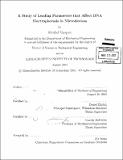| dc.contributor.advisor | Daniel Ehrlich and Gareth McKinley. | en_US |
| dc.contributor.author | Vázquez, Maribel, 1971- | en_US |
| dc.contributor.other | Massachusetts Institute of Technology. Dept. of Mechanical Engineering. | en_US |
| dc.date.accessioned | 2005-08-23T19:01:53Z | |
| dc.date.available | 2005-08-23T19:01:53Z | |
| dc.date.copyright | 2001 | en_US |
| dc.date.issued | 2001 | en_US |
| dc.identifier.uri | http://hdl.handle.net/1721.1/8302 | |
| dc.description | Thesis (Sc. D.)--Massachusetts Institute of Technology, Dept. of Mechanical Engineering, 2001. | en_US |
| dc.description | Includes bibliographical references (p. 206-220). | en_US |
| dc.description.abstract | Electrophoresis of DNA has become particularly attractive in today's age of bio-technology. The goal of the present research is to optimize the the gel-loading and sample-loading protocols used prior to electrophoresis within microfabricated devices. During gel-loading, electrophoretic channels are filled with a polymer matrix prior to their use in DNA separations. The injection rate is constrained by the desire to minimize shear-induced degradation of the polymer molecules. In this study, measurements of the zero shear-rate viscosity of linear polyacrylamide (LPA) solutions are used to determine the LPA molecular weight before and after gel-loading protocols. The results demonstrate induced molecular degradation of polymer molecules even when matrixes are injected at minimal flow rates of 1 microliter per minute. Next, digital images are used to analyze the electrophoretic migration of DNA samples during conventional sample-loading and injection protocols. Experimental data illustrate that the 'stacked' DNA sample plug is comprised of distinct concentrated populations of DNA molecules that migrate with the same mechanism of transport. This study produced a detailed exploration of the injection process as well as a standardized method to measure the level of 'stacking' exhibited by a system. Additionally, a novel high voltage injection protocol correlates increases in resolution and separation with higher levels of sample stacking during injection. Developments realized through these experiments demonstrate great promise for upgraded electrophoretic protocols and future microdevices. | en_US |
| dc.description.statementofresponsibility | by Maribel Vazquez. | en_US |
| dc.format.extent | 220 p. | en_US |
| dc.format.extent | 16627387 bytes | |
| dc.format.extent | 16627144 bytes | |
| dc.format.mimetype | application/pdf | |
| dc.format.mimetype | application/pdf | |
| dc.language.iso | eng | en_US |
| dc.publisher | Massachusetts Institute of Technology | en_US |
| dc.rights | M.I.T. theses are protected by copyright. They may be viewed from this source for any purpose, but reproduction or distribution in any format is prohibited without written permission. See provided URL for inquiries about permission. | en_US |
| dc.rights.uri | http://dspace.mit.edu/handle/1721.1/7582 | |
| dc.subject | Mechanical Engineering. | en_US |
| dc.title | A study of loading parameters that affect DNA electrophoresis in microdevices | en_US |
| dc.type | Thesis | en_US |
| dc.description.degree | Sc.D. | en_US |
| dc.contributor.department | Massachusetts Institute of Technology. Department of Mechanical Engineering | |
| dc.identifier.oclc | 50444365 | en_US |
